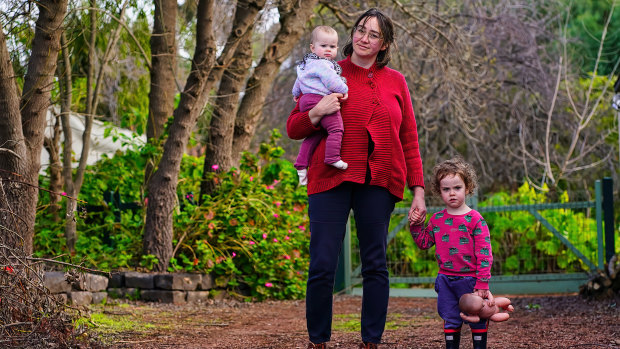Families expecting some relief from increased childcare subsidies are being slugged with fee hikes as centres struggle to meet rising costs and some experts worry providers are being opportunistic.
The federal government said the increase in childcare subsidy rates, which will cost $5.4 billion over four years and apply from July, will make childcare cheaper for around 1.2 million families, including 265,000 families in regional areas.

Katie Dircks with her children Ernie, 2, and Ada, 8 months, at their home in Bendigo.Credit: Luis Enrique Ascui
The family income limit will increase from $356,756 to $530,000 a year and families earning $80,000 or less will qualify for a childcare subsidy of 90 per cent.
However, The Parenthood chief executive Georgie Dent said a lot of families were contacting the organisation with concerns about fee increases, when they had been expecting a reduction in costs owing to the new childcare policy.
“For a lot of families after rent, mortgage, if you have children who are five and under – early education is usually the next biggest expense in a family budget,” she said.
She said with inflation and higher expenses – cost of nappies, food, electricity – some increases were “inevitable”, but it was hard to determine the extent fee increases were opportunistic or necessary.
“If [a childcare centre’s] objective is to make a profit, you can see why there might be more inclination to put fees up purely for financial reasons,” she said.
Katie Dircks has a two-year-old and an eight-month-old in childcare near Bendigo.
The arts administrator, who is currently on maternity leave but has to keep her children in care to keep their places, said a fee rise of more than 12 per cent meant she would see little of the expected increase in childcare subsidy.
“It’s incredibly frustrating ... we’re burning through our savings. That was going to make a difference for us,” she said.
Dircks said she wouldn’t begrudge the fee rise if the money was going to the centre’s educators, but she dismissed widespread increases as “entirely opportunistic” by centres.
“The design of that childcare subsidy increase was to ease the cost of living. It wasn’t supposed to be a bailout to the childcare centres,” she said.
Dircks said families were more reliant on childcare as inflationary pressures continued to grow.
“It’s not so mothers can sit at home and eat bon bons. Who’s surviving on a single income these days?”
Kindicare founder and chief executive Benjamin Balk said they were seeing price increases mid-year of between 7 per cent and 11 per cent across both for-profit and non-for-profit early learning providers.
Higher fee increases on a dollar basis were happening more at centres within 30 kilometres of Melbourne, but he said while there were exceptions, he wasn’t seeing childcare providers actively increasing fees to take advantage of the increase in the childcare subsidy.
G8 Education, one of Australia’s largest childcare providers, increased fees 6 per cent in January and a further 3.88 per cent mid-year.
Not-for-profit Goodstart Early Learning is increasing its fees by 7.8 per cent, allowing it to fund a “historic” 7.5 per cent increase in wages, and to account for increasing operational costs owing to inflation. Goodstart’s food bill has increased by 16 per cent and rent by about 8 per cent.
However, a Goodstart spokesperson said more than 90 per cent of their families would be better off when the increased subsidy and the fee changes were enacted.
Minister for Early Childhood Education Anne Aly said there were already hourly rate caps in place to put downward pressure on fees, and the Australian Competition and Consumer Commission had been tasked with investigating factors that drive childcare fee increases.
Aly said early childhood educators did important and highly skilled work, and it was important they were properly valued, “recognising their profession is crucial to attracting and retaining workers”.
Katie Roberts-Hull has two children in childcare at a non-profit centre in inner Melbourne. Her fees will rise by 11.65 per cent next month.
Roberts-Hull, who works in education policy, said she didn’t blame centres for raising fees, but she was now considering sending her youngest to free kinder as well as his usual long day care.
That would mean disrupted care for her son and less flexible work hours for Roberts-Hull and her partner.
The Victorian government is making kinder free for all three and four-year-olds, but childcare falls under the remit of the federal government.
Prime Minister Anthony Albanese on Saturday dismissed opposition claims that cost relief measures would add to inflation.
Following an inquiry, the Productivity Commission will release its final report into the childcare sector next year.
A Victorian government spokesperson said free kinder was scaling up to 15 hours of three-year-old and 30 hours of four-year-old kinder, saving families $2500 a year for each child enrolled in the service and “backing parents – especially mums – to get back into the workforce sooner if they want”.
Get the day’s breaking news, entertainment ideas and a long read to enjoy. Sign up to receive our Evening Edition newsletter here.
https://news.google.com/rss/articles/CBMihAFodHRwczovL3d3dy50aGVhZ2UuY29tLmF1L25hdGlvbmFsL3ZpY3RvcmlhL2NoaWxkY2FyZS1zdWJzaWR5LWJvb3N0LWFscmVhZHktYmVpbmctZWF0ZW4tdXAtYXMtY2VudHJlcy1saWZ0LWZlZXMtMjAyMzA2MjYtcDVkamVoLmh0bWzSAYQBaHR0cHM6Ly9hbXAudGhlYWdlLmNvbS5hdS9uYXRpb25hbC92aWN0b3JpYS9jaGlsZGNhcmUtc3Vic2lkeS1ib29zdC1hbHJlYWR5LWJlaW5nLWVhdGVuLXVwLWFzLWNlbnRyZXMtbGlmdC1mZWVzLTIwMjMwNjI2LXA1ZGplaC5odG1s?oc=5
2023-06-26 09:28:31Z
2153249731
Bagikan Berita Ini














0 Response to "Childcare subsidy boost already being eaten up as centres lift fees - The Age"
Post a Comment